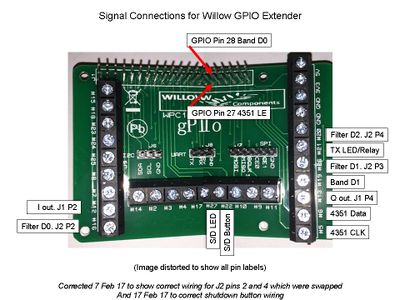Difference between revisions of "Willow components breakout card"
Jump to navigation
Jump to search
(Created page with "Before the team designed the Portsdown GPIO breakout card we recommended the use of the Willow Components GPIO Extender board. If you have bought the BATC card you DO NOT NE...") |
(Portsdown 4) |
||
| Line 8: | Line 8: | ||
Note that 2 of the signals are not broken out to the screw connectors on the Willow board, and so you will need to solder thin wires to extended GPIO pins 27 and 28. Using thin wires it is possible to do this and still mount the display directly above the board. | Note that 2 of the signals are not broken out to the screw connectors on the Willow board, and so you will need to solder thin wires to extended GPIO pins 27 and 28. Using thin wires it is possible to do this and still mount the display directly above the board. | ||
| + | |||
| + | On Portsdown 4, pins 27 and 28 are not connected, so this Willow board may find a use as the breakout board and aid making all the Langstone connections. | ||
[[File:Willow Wires.jpg|200px]] | [[File:Willow Wires.jpg|200px]] | ||
Latest revision as of 12:07, 5 April 2021
Before the team designed the Portsdown GPIO breakout card we recommended the use of the Willow Components GPIO Extender board.
If you have bought the BATC card you DO NOT NEED to read this section!
Details of wiring up the Willow board is complex and illustrated below. The numbers on the Willow Board refer to the BCM (Broadcomm) numbers in the table below.
Note that 2 of the signals are not broken out to the screw connectors on the Willow board, and so you will need to solder thin wires to extended GPIO pins 27 and 28. Using thin wires it is possible to do this and still mount the display directly above the board.
On Portsdown 4, pins 27 and 28 are not connected, so this Willow board may find a use as the breakout board and aid making all the Langstone connections.

